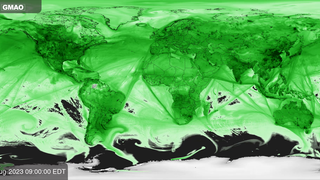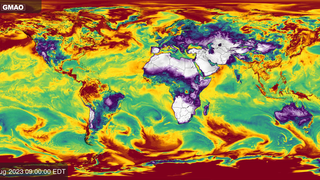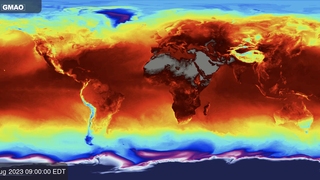Earth
ID: 5151
Predictions of air pollution are created using complex models that combine information about weather and the emissions, transformation, and transport of chemical species and particles. The Goddard Earth Observing System Composition Forecasting (GEOS-CF) system is a research model maintained by NASA’s Global Modeling and Assimilation Office to help scientists understand the causes and impact of air pollution. It is one of the highest resolution and most detailed models of its kind in the world, made possible through ongoing collaborations between NASA and university scientists. GEOS-CF tracks the concentrations of hundreds of gas phase chemical species and dozens of types of particles characterized by their composition and size. It is used by a wide variety of stakeholders around the world to develop new methods for improving local predictions, understanding the impact of pollution on human health, and improving the quality of NASA satellite datasets.
Scientists and air quality managers carefully track the concentrations of small particulate matter because it contributes to increased risk of asthma, respiratory inflammation, and poor lung function. PM2.5 is calculated using near surface GEOS-CF fields of numerous aerosol types, temperature, and pressure. The slight pulsing that is visible reflects variations in pollution throughout the day as a result of traffic cycles and weather variations. Though small particles typically remain in the atmosphere for only a few days, they can be transported far away from source regions by large scale weather systems. In many parts of the U.S. and Europe, PM2.5 levels have decreased substantially in recent decades due to improvements in technology and regulation. However, increases in the frequency, severity, and duration of wildfires in response to climate change can put communities worldwide at risk of exposure.
Particulate Matter (PM) 2.5
Scientists and air quality managers carefully track the concentrations of small particulate matter because it contributes to increased risk of asthma, respiratory inflammation, and poor lung function. PM2.5 is calculated using near surface GEOS-CF fields of numerous aerosol types, temperature, and pressure. The slight pulsing that is visible reflects variations in pollution throughout the day as a result of traffic cycles and weather variations. Though small particles typically remain in the atmosphere for only a few days, they can be transported far away from source regions by large scale weather systems. In many parts of the U.S. and Europe, PM2.5 levels have decreased substantially in recent decades due to improvements in technology and regulation. However, increases in the frequency, severity, and duration of wildfires in response to climate change can put communities worldwide at risk of exposure.
Used Elsewhere In
Related
Visualization Credits
Joseph V. Ardizzone (NASA/GSFC): Lead Visualizer
Please give credit for this item to:
NASA’s Global Modeling and Assimilation Office
NASA’s Global Modeling and Assimilation Office
Science Paper:
Keller, C. A., Knowland, K. E., Duncan, B. N., Liu, J., Anderson, D. C., Das, S., Lucchesi, R. A., Lundgren, E. W., Nicely, J. M., Nielsen, E., Ott, L. E., Saunders, E., Strode, S. A., Wales, P. A., Jacob. D. J., and Pawson, S. (2021). Description of the NASA GEOS composition forecast modeling system GEOS-CF v1.0. Journal of Advances in Modeling Earth Systems, 13, e2020MS002413. https://doi.org/10.1029/2020MS002413
Short URL to share this page:
https://svs.gsfc.nasa.gov/5151
Data Used:
Note: While we identify the data sets used in these visualizations, we do not store any further details nor the data sets themselves on our site.
Keywords:
SVS >> Hyperwall
SVS >> GMAO
NASA Science >> Earth
NASA Earth Science Focus Areas >> Atmospheric Composition
SVS >> Earth Information Center
Keller, C. A., Knowland, K. E., Duncan, B. N., Liu, J., Anderson, D. C., Das, S., Lucchesi, R. A., Lundgren, E. W., Nicely, J. M., Nielsen, E., Ott, L. E., Saunders, E., Strode, S. A., Wales, P. A., Jacob. D. J., and Pawson, S. (2021). Description of the NASA GEOS composition forecast modeling system GEOS-CF v1.0. Journal of Advances in Modeling Earth Systems, 13, e2020MS002413. https://doi.org/10.1029/2020MS002413
Short URL to share this page:
https://svs.gsfc.nasa.gov/5151
Data Used:
GEOS-CF
NASA GMAO
Knowland, K.E., C.A. Keller, and R. Lucchesi, 2022: File Specification for GEOS-CF Products. GMAO Office Note No. 17 (Version 1.3), 54 pp, available from [https://gmao.gsfc.nasa.gov/pubs/docs/Knowland1446.pdf](https://gmao.gsfc.nasa.gov/pubs/docs/Knowland1446.pdf)
Keywords:
SVS >> Hyperwall
SVS >> GMAO
NASA Science >> Earth
NASA Earth Science Focus Areas >> Atmospheric Composition
SVS >> Earth Information Center



















